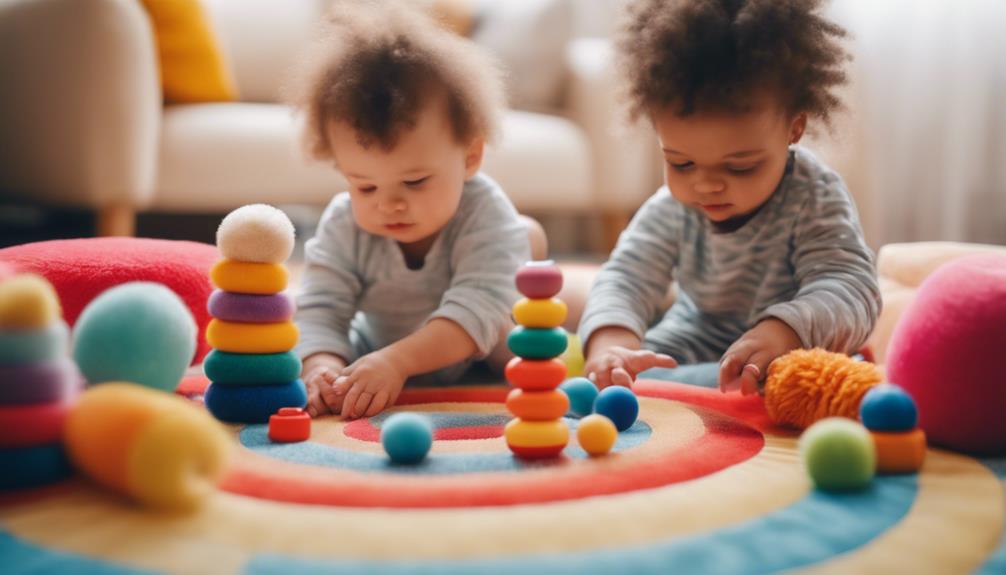Engage your baby with exciting activities like swinging, which can help promote balance and coordination. Consider wearing your baby for skin-to-skin contact, as it can reduce fussiness and aid in breastfeeding. Create a mobile to enhance cognitive development through visual and tactile stimulation. Spice up tummy time by using colorful toys to strengthen core muscles and stimulate the senses. Playing musical instruments can help develop sensory skills and strengthen the bond between parent and child. Teaching sign language can improve communication and IQ. Engaging in cause and effect activities can also enhance cognitive development. Playing with dolls can boost empathy, social skills, and creativity. Discover these activities for both fun and developmental purposes.
Key Takeaways
- Swing Time: Improves balance, coordination, and muscle strength with cost-effective bedsheet swinging.
- Wear Your Baby: Promotes skin-to-skin contact, reduces fussiness, and mimics soothing womb environment.
- Make a Mobile: Stimulates senses, promotes cognitive development, and enhances sensory play with DIY project.
- Musical Instrument Play: Enhances sensory development, creativity, and fine motor skills while introducing rhythm.
- Sign Language Benefits: Enhances communication, reduces frustration, and fosters a deeper bond with parents.
Swing Time
Guarantee your baby's safety in swing time using a bedsheet for sensory stimulation and gentle movement. This playful activity not only provides entertainment but also aids in your baby's development. Swinging helps improve balance, coordination, and muscle strength, laying a strong foundation for their physical growth. The rhythmic motion of swinging can have a calming effect, offering comfort to your little one.
Using a bedsheet for swinging is a cost-effective and simple way to bond with your baby through play. Supervise the activity closely to maintain a safe environment and prevent any accidents while ensuring your baby's comfort throughout.
As you swing your baby gently, observe their reactions to gauge their enjoyment and adjust the movement accordingly. Remember, the primary goal is to engage in a fun and interactive experience that benefits both you and your baby.
Wear Your Baby

For enhanced bonding and convenience in your daily routine, consider wearing your baby. Babywearing promotes skin-to-skin contact, which regulates their body temperature and heart rate, creating a nurturing environment essential for infant development. This physical closeness fosters a strong emotional bond between you and your baby, providing comfort and security.
The benefits extend beyond bonding; babywearing allows for hands-free movement, enabling you to engage in daily activities while keeping your little one close.
Research suggests that wearing your baby can help reduce crying and fussiness. By mimicking the womb environment with gentle movements and close contact, babywearing soothes infants, making them feel safe and calm. This practice has been linked to improved breastfeeding success and overall better development in babies.
Dr. William Sears, a renowned pediatrician, emphasizes the importance of babywearing in building a secure attachment: 'The more your baby is held, the less they cry and the more secure they feel.' Consider incorporating babywearing into your routine for a closer, more connected relationship with your child.
Make a Mobile
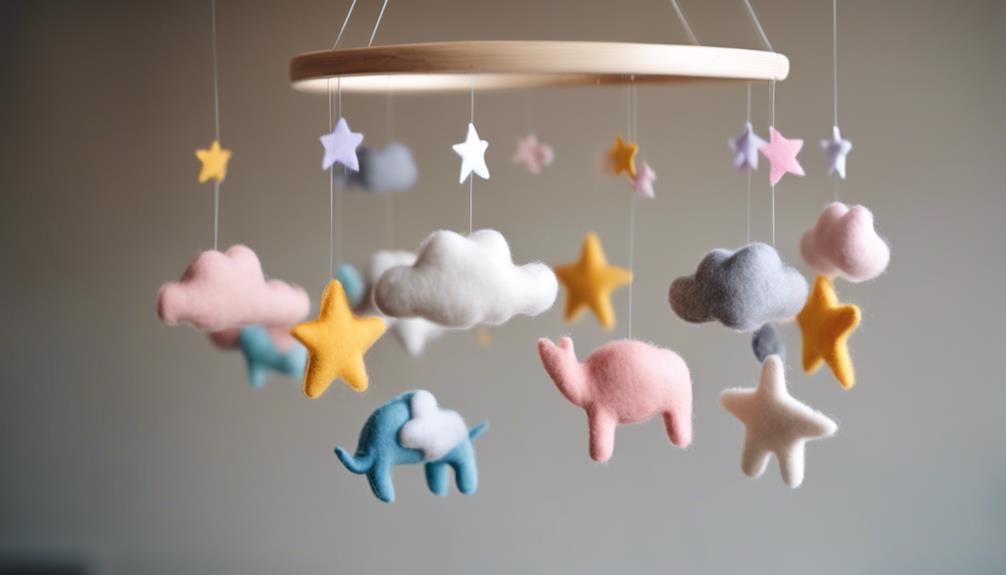
Creating a homemade mobile can be a delightful way to stimulate your baby's visual and tactile senses. By incorporating contrasting colors, lightweight materials, and various shapes and textures, you can engage your baby in sensory play while also enhancing their fine motor skills. Hanging a customized mobile above your baby's crib not only provides visual stimulation but also promotes cognitive development. Personalizing the mobile with themes like animals, shapes, or patterns can capture your baby's interest and make the experience even more engaging.
To guide you in creating a stimulating mobile for your little one, consider the following table:
| Materials Needed | Steps to Make the Mobile |
|---|---|
| Lightweight paper or foam | 1. Cut out shapes or patterns. |
| Colorful yarn or string | 2. Punch holes in the shapes. |
| Wooden or plastic hoop | 3. Attach shapes to the hoop using yarn. |
Engage in this DIY project to enhance your baby's sensory play and provide them with valuable visual stimulation.
Twist on Tummy Time

Try incorporating a fun twist on tummy time to enhance your baby's development and engagement. During tummy time, introduce playful movements such as gently rocking side to side or up and down. These movements not only make tummy time more engaging for your baby but also help in building essential core muscles.
Additionally, consider placing colorful toys or mirrors within your baby's reach to capture their attention and stimulate their senses during this important developmental activity. By adding these interactive elements, you can make tummy time a more enjoyable experience for your little one while still reaping the benefits it offers in strengthening neck and upper body muscles.
As pediatric occupational therapist Rachel Cole explains, "Incorporating playful movements and colorful toys during tummy time helps babies develop their core muscles, which are vital for achieving future milestones like crawling and sitting up." So, get creative and make tummy time a fun and fruitful part of your baby's daily routine.
Make Some Noise

When interacting with a baby, it's crucial to incorporate activities that involve making noise. Musical instrument play, such as using rattles and shakers, can help babies explore sounds and develop sensory skills.
Singing songs with various tones and rhythms can also engage a baby's auditory senses and promote interactive play.
Musical Instrument Play
Enhance your baby's sensory development and creativity by engaging in musical instrument play with homemade instruments. Using simple musical instruments like shakers or drums can provide sensory stimulation for your baby, allowing them to explore different sounds and textures. This sensory experience can help in developing fine motor skills as they grasp and manipulate the instruments.
According to child development experts, musical activities can also introduce babies to rhythm and foster an appreciation for music from an early age.
Playing with homemade instruments not only supports sensory development but also encourages creativity in your baby. As you engage in musical play together, you're creating a bonding experience that's both fun and interactive. This shared experience allows for meaningful interactions between you and your baby, promoting a strong parent-child relationship.
Singing and Clapping
Engage your baby in fun and interactive activities by incorporating singing and clapping to stimulate their rhythm and language skills.
Singing and clapping can help babies develop a sense of rhythm and enhance their language skills. The combination of music and movement engages multiple senses in babies, aiding in their cognitive development.
Clapping along to songs not only encourages participation but also improves coordination and motor skills in infants. Singing nursery rhymes is a great way to boost cognitive development and memory retention in babies.
Interactive singing and clapping activities not only benefit your baby's development but also create special bonding moments between you and your little one.
- Singing and clapping can help babies develop rhythm and language skills.
- The combination of music and movement engages multiple senses in babies.
- Clapping along to songs can improve coordination and motor skills in infants.
- Singing nursery rhymes helps with cognitive development and memory retention in babies.
Ready for Takeoff

Get ready to soar to new heights with your baby by trying out the fun and engaging activity of playing airplane. This interactive play not only fosters a strong bond between you and your little one but also helps in strengthening their core muscles and promoting physical development. By simulating the sensation of flying, the bedsheet swing activity provides sensory stimulation and enhances your baby's vestibular system, contributing to their overall sensory development. Through movement-based activities like play airplane, you can assist your baby in enhancing their balance and coordination skills, setting a solid foundation for their physical growth. These activities serve as more than just playtime; they are essential for your baby's development and well-being.
| Benefits of Play Airplane | Description |
|---|---|
| Strengthen Core Muscles | Improves physical strength and stability. |
| Promote Physical Development | Enhances overall motor skills and coordination. |
| Sensory Stimulation | Engages vestibular system and sensory experiences. |
Learn Sign Language
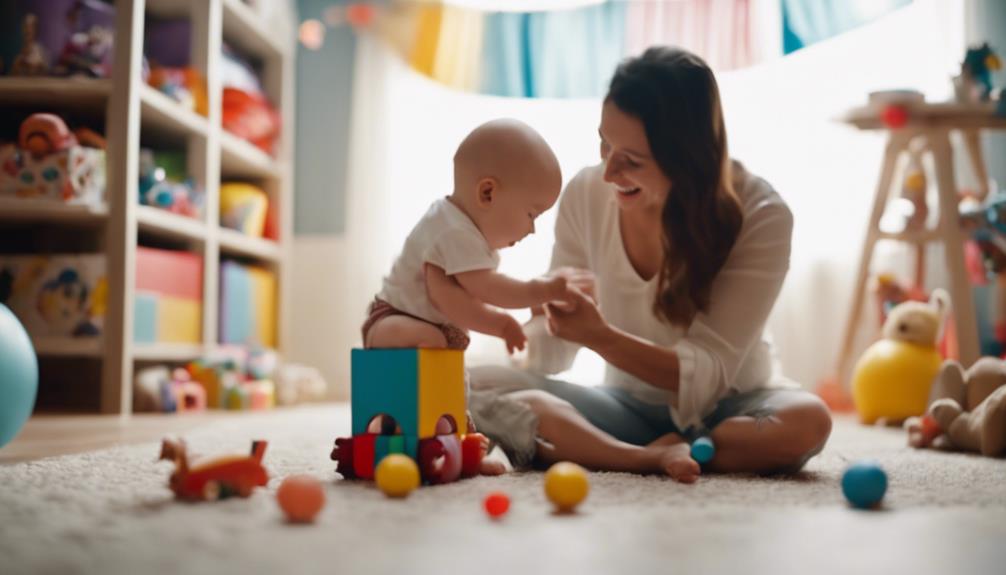
Sign language can be a valuable tool for enhancing communication skills in babies from a young age. Teaching sign language to babies not only aids in early communication but also reduces frustration for both the child and the caregiver. Research suggests that babies as young as 6 months old can learn simple signs like 'more,' 'milk,' and 'all done,' enabling them to express their needs effectively.
Furthermore, studies indicate that babies who learn sign language may develop higher IQs and better language skills later in life, showcasing the long-term benefits of early exposure to signing.
Babies can strengthen their communication skills through sign language, fostering a deeper bond with their parents.
Learning sign language empowers babies to convey their thoughts and needs before they can verbally communicate.
Early exposure to sign language can enhance a child's cognitive development and language acquisition.
Using sign language with babies can create a shared understanding and promote smoother interactions between parent and child.
Cause and Effect
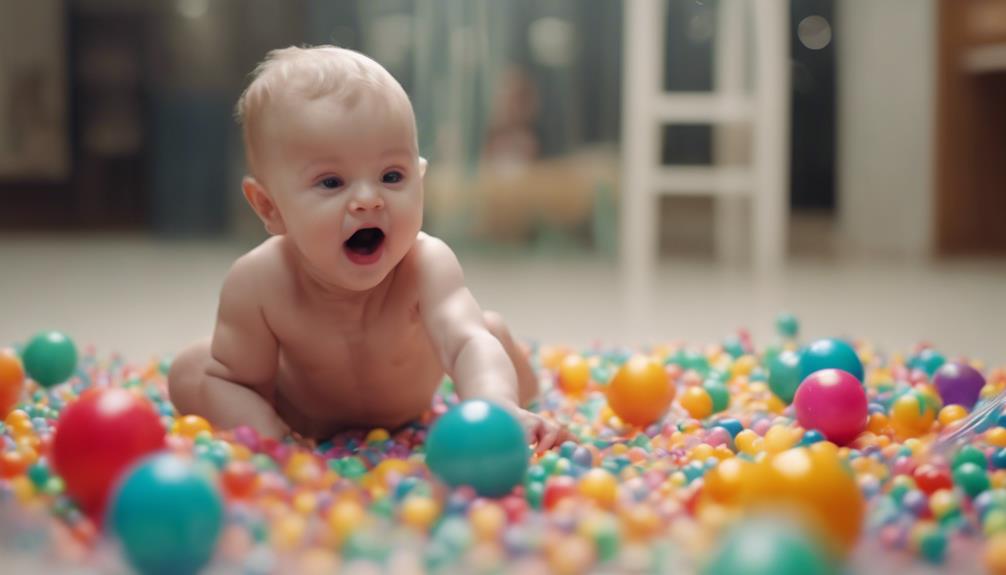
To help babies grasp the concept of cause and effect, incorporate interactive activities that demonstrate how their actions lead to specific outcomes. Engaging in cause and effect activities is crucial for a baby's cognitive development. Simple games like dropping a toy and observing it fall can help them understand cause and effect relationships. Pressing a button on a toy to activate music or lights is another effective way to teach this concept. Exploring toys that require a specific action to produce a response can enhance a baby's hand-eye coordination and overall understanding of cause and effect.
| Cause and Effect Activities | Benefits |
|---|---|
| Dropping a toy and observing it fall | Enhances baby's understanding of cause and effect relationships |
| Pressing buttons on toys to activate sounds or lights | Improves hand-eye coordination and cognitive development |
| Exploring toys with specific action-response mechanisms | Enhances overall understanding of cause and effect |
Make Musical Instruments
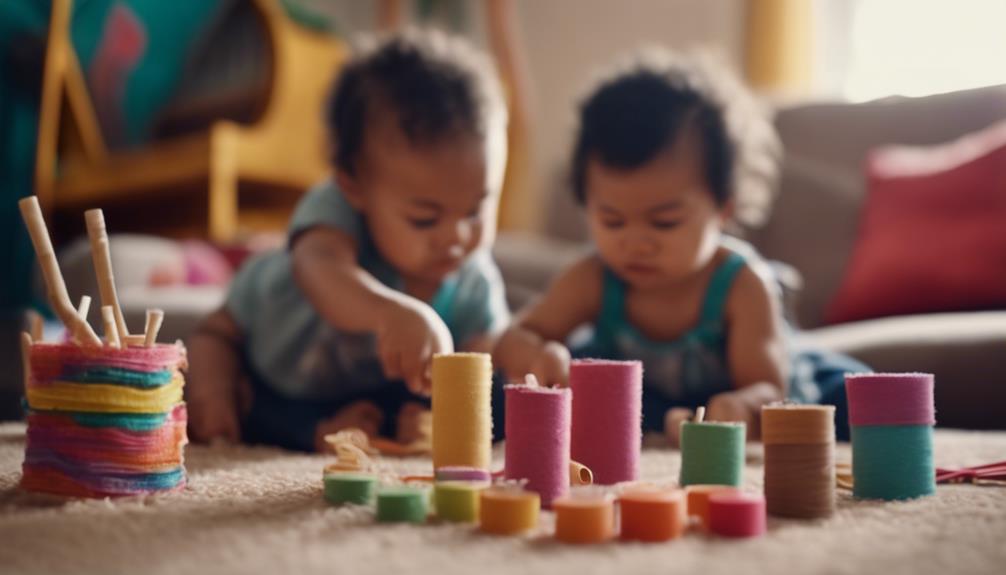
Crafting homemade musical instruments is an engaging and creative way to introduce babies to the world of music and sound. Making music with DIY instruments using household items can be a fun activity for both you and your little one.
Here are some ideas to get you started:
- Create shakers by filling empty plastic bottles with rice or beans to make rhythmic sounds.
- Turn empty oatmeal canisters into drums by covering one end with paper and tapping on it with your hands or wooden spoons.
- Make a simple tambourine by attaching jingle bells to a paper plate and shaking it gently to create jingling sounds.
- Explore different textures and sounds by filling empty containers with various materials like dried pasta or buttons to make sensory shakers.
Engaging in these music-making activities can't only provide entertainment but also aid in your baby's sensory and auditory development. Enjoy the process of creating music together and watch as your little one discovers the joy of sound.
Play With Dolls
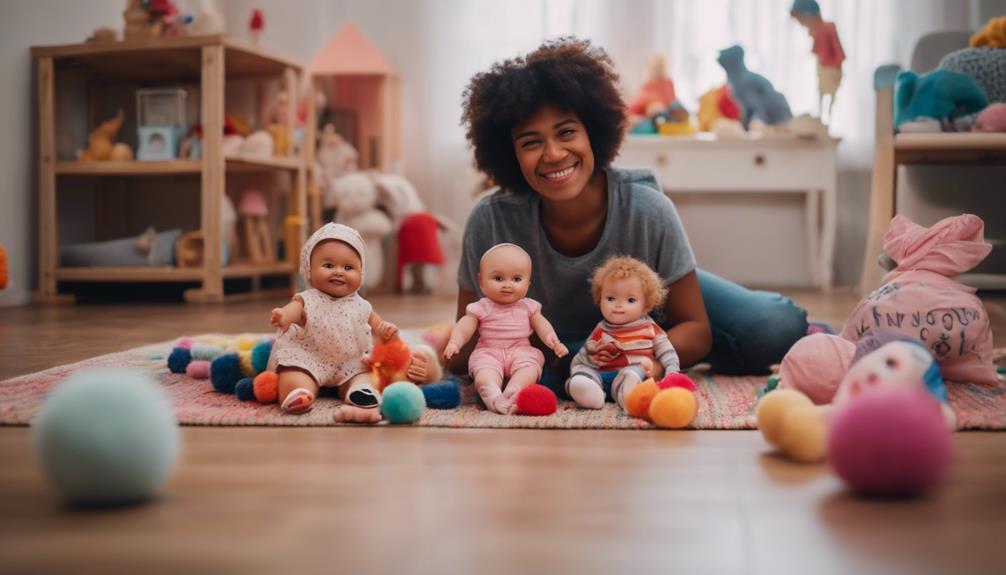
Playing with dolls offers a range of benefits for your child's development. Through role-playing with dolls, children can enhance their imaginative skills and empathy, fostering a sense of care and compassion.
Engaging in storytelling with dolls also helps in language development, as children create narratives and dialogue while playing.
Role-Play With Dolls
Engage your child in role-playing with dolls to enhance their social skills and foster empathy. Playing with dolls offers a myriad of benefits for your child's development:
- Social Skills: Through role-playing with dolls, children learn to interact with others, take turns, and communicate effectively.
- Imaginative Play: Doll play encourages creativity and imagination as children create scenarios and stories with their dolls.
- Empathy: By pretending to be in the doll's shoes, children learn to understand and share the feelings of others, fostering empathy.
- Storytelling: Doll play provides a platform for children to engage in storytelling, which enhances their language skills and narrative abilities.
Engaging in role-play with dolls not only brings joy to your child but also aids in their emotional and cognitive growth. Encourage this form of play to see your child blossom socially and emotionally.
Storytelling With Dolls
Immerse your child in the world of storytelling with dolls to spark their imagination and enhance their cognitive and social skills. Playing with dolls is more than just fun; it's a valuable tool for promoting imaginative play. Through creating stories and scenarios with dolls, children can explore different possibilities and exercise their creativity.
Doll play also contributes to the development of empathy and social skills. As children engage in storytelling with dolls, they learn to understand and express emotions, thereby enhancing their ability to relate to others.
Furthermore, using dolls for storytelling aids in language development. By narrating their doll's adventures, children practice forming sentences and expressing ideas. This process strengthens communication skills and vocabulary.
Additionally, doll play fosters fine motor skills as children manipulate the dolls, dress them up, and interact with various accessories. These activities require precision and coordination, supporting the development of dexterity in young children.
Dress-Up Doll Fun
Get ready to release your creativity and style with dress-up doll fun! Playing with dolls not only sparks imaginative play but also nurtures creativity and self-expression. By dressing up dolls in various outfits, you can explore different styles and themes, allowing your imagination to run wild.
Engaging in doll play can also help you develop empathy and social skills. Through interacting with your dolls, you learn to understand emotions and practice social scenarios, enhancing your ability to relate to others.
As you engage in conversations and role-play with your pretend companions, you're actively honing your language skills and communication abilities.
Furthermore, manipulating clothing and accessories during doll play can aid in fine motor skill development. The intricate movements required to dress and accessorize your dolls contribute to enhancing your dexterity and coordination.
Frequently Asked Questions
How Do You Engage in Play With a Baby?
To engage in play with a baby, you can interact through games like peek-a-boo, tummy time, and dancing. Reading colorful books, singing rhymes, and using toys will boost language skills. Sensory play with textures, mirrors, and music aids exploration.
What Are the Benefits of Playing With Your Baby?
Playing with your baby offers a myriad of benefits such as enhancing sensory development, boosting cognitive skills, and promoting social and emotional growth. It strengthens the bond between you both and provides educational and developmental advantages.
What Does Playing With Babies Teach Children?
Playing with babies teaches them valuable life lessons. Sharing, turn-taking, motor skills, language development, problem-solving, and creativity all blossom through play. Bonding during these activities strengthens your relationship, building trust and a strong foundation for the future.
How Can You Entertain a Baby?
To entertain a baby, engage in tummy time with colorful toys, play peek-a-boo with a soft blanket, introduce high-contrast black and white books, use interactive board books, and sing nursery rhymes together. These activities promote growth and development.
Conclusion
To sum up, playing with a baby can be a fun and engaging experience for both parties involved. By incorporating activities such as Swing Time, wearing your baby, making a mobile, and playing with dolls, you can enhance the bond between you and the baby.
Remember, these activities not only provide entertainment but also promote cognitive and physical development. So, next time you interact with a baby, try out some of these activities to create lasting memories and strengthen your connection with them.

